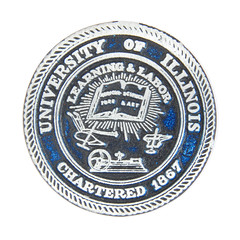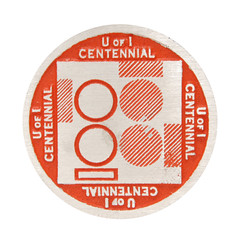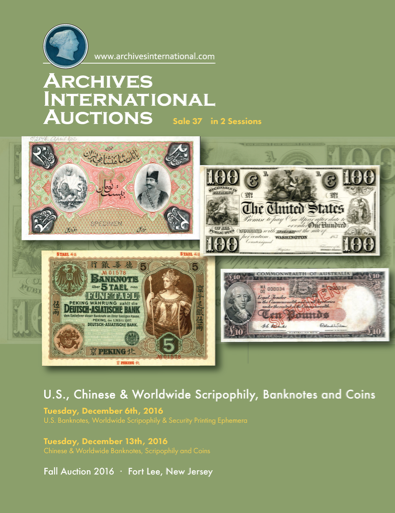
PREV ARTICLE
NEXT ARTICLE
FULL ISSUE
PREV FULL ISSUE
VOCABULARY TERM: ACID ETCHINGDick Johnson submitted this entry from his Encyclopedia of Coin and Medal Terminology. Thanks. -Editor
  This unusual acid-etched medal was made by photoetching from black-and-white images. Etched on one side of an aluminum sheet, it is turned over for etching the reverse with exact positioning. Numerous pieces are arranged on a large plate. Color is added by paint in the sunken etched areas. It is not a popular method of medal manufacture. Acid Etching. Controlled incuse biting or eating away of metal – by acid – on a metallic piece. Acid etching is an inexpensive and fairly quick method of removing small amounts of metal from the surface of a metallic object either in producing RELIEF ETCHING, eating away all incuse areas and leaving the raised relief, or by incuse lettering – as in INSCRIBING (even on the edges of medals). Etching technique is simple and materials used are readily available: acid, wax, water, alcohol and sharp pointed tools. But the process of etching is a chemical one and experience is necessary for best control of the actual dissolving of metal by the acid solution. While hand-carved etching is still practiced – for inscribing letters on existing medals – the modern process of PHOTOETCHING has infrequently been employed to create a total medal or a relief-etched model from which a die is made. Such acid-etched medals are typical biplanar – with two planes – one the original background surface, the other a lower plane of the etched surface. The process cannot produce MODULATED RELIEF. Acids used. Nitric acid (HNO3), hydrochloric acid (HCl) or ferric chloride (FeC3) are the most used mordants, acids for etching metals; hydrochloric and ferric chloride are also called Dutch mordants. Several factors affect acid etching: (1) strength of the acid – all are used in water solution, but the stronger the acid the more active the action; (2) age of the acid – fresher is stronger; (3) temperature of the solution and the atmosphere – warmer is stronger; and (4) composition of the metal. The action of the acid on the metal is called a bite. Ideally the acid should be controlled, not allowed to cut or bite continuously as it eats away in all directions, often causing an UNDERCUT. Procedure. The object to be acid etched, irrespective of the location of the etching on the object, is completely covered with wax – called ETCHING GROUND (in effect, a STOP-OFF) – denatured beeswax or beeswax mixed with bitumen and resin. The wax is melted and the object is immersed to cover it completely (generally immersed a second time after turning it on the rack or holder to eliminate a RACK MARK). Once the wax is hardened it can be carved – with a scribe or burin or other sharp-pointed tool – wherever the etching is required on the object. Very fine lines, of any width required can be achieved by scraping away the wax down to the metal surface. Obviously, care must be exercised not to remove any wax where etching is not wanted – which is causes a FOUL BITE. The mordant solution – acid mixed with water – is placed in a glass container larger than the object to be etched. The wax-coated object with scribed lines or design is then immersed in the solution. Time is critical – the longer it is left in the solution – the deeper the bite. In commercial applications the wax-coated object is usually not placed in the container where acid is administered on top. (This would cause the acid to etch downward and be difficult to control.) Instead the object is placed on a surface where the acid eats upward. The object is attached to the lid of the container and the acid is sprayed or thrown upward onto the work. The acid eats upward with greater control. After etching, the object is then washed thoroughly in running water to stop the acid action. Additional carving may be done at this time, or the wax removed by immersion in alcohol. The process can be repeated any number of times for additional etching or for deepening the incuse areas even more. (The action of repeated immersion and withdrawing is called a creeping bite.) Photoetching. A photoetched design can be made from a pen-and-ink drawing or any contrasting black-and-white artwork. The process is the same as photoengraving, making printers' plates in zinc or copper by etching away the part that does not print, and leaving as raised and unaffected the surface that will print by letterpress. The design for a medal is generally prepared oversize and photographically reduced or sized to the intended medal or model. It is then etched by a similar process as acid etching on a copper disk. There is no modulated relief on such a medal – it is a flat surface with incuse design. ENGRVING MASTERS are made by the photoetching process in which lettering or illustrations can be etched, even on the same master. For use in an engraving machine the images would have to be right reading or wrong reading (mirror image), depending upon the process. Finishing the etched surface. Acid etching, of any kind, causes an etched surface that is not smooth but one that has a multitude of microscopic cups similar to abrasive blasting. These can be smoothed by relieving with pumice slurry and finished as a normal medallic item. Often, however, the incuse area of design or lettering is given a FILL-IN with ENAMEL, MONOGRAM FILLER or other coating (even paint or ORGANIC COATING). In such a case the acid etched surface is not a problem but is actually a benefit. The enamel, fill-in or coating adheres to the irregular surface with its microscopic cups more so than a smooth surface. A rather crude example of acid etching occurred in 1949 by two numismatists who wanted to create a memento for the fifth convention of the New England Numismatic Association. For 100 large cents they planed smooth the reverse then with a rubber stamp with appropriate lettering stamped acid onto this surface to create incise lettering. Such a homemade example was not repeated; they had conventional medals made three years later. CLASS 07.8  Wayne Homren, Editor The Numismatic Bibliomania Society is a non-profit organization promoting numismatic literature. See our web site at coinbooks.org. To submit items for publication in The E-Sylum, write to the Editor at this address: whomren@gmail.com To subscribe go to: https://my.binhost.com/lists/listinfo/esylum All Rights Reserved. NBS Home Page Contact the NBS webmaster 
|